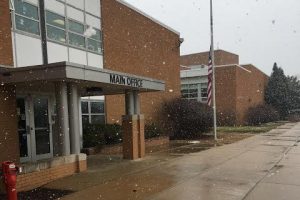Collision consequences
David Bregande, senior, was involved in a serious car crash that almost ended his football career and his life.
The adrenaline was building. He continued to press on the accelerator, no thought of stopping in his head while the open road flew by him. The wind rushed past him, while he had no care in the world.
Then it all stopped.
David Bregande, senior, was in a head-on collision with another vehicle on W. Adams June 6 around 11 p.m. Driving approximately 50 mph, he lost control of the car, so he could not brake quickly enough. Upon impact, his head slammed on the steering wheel and no airbag deployed.
“When I looked down, blood was all along my dashboard and my shirt,” Bregande said. “I don’t even remember the pain, just the blood squirting out on the inside of the car and my body. I almost lost consciousness from the shock, not the impact.”
Shortly after the accident, ambulances arrived at the scene. Bregande was taken to the emergency room where he was later diagnosed with a stage two trauma head wound, which for Bregande required brain scans and surgery. Treatment included a large laceration wrapping around the front of his skull that needed 24 stitches to close.
“In the hospital, they had me do a series of tests to see if I had memory loss, which thankfully I passed,” Bregande said. “I had to rebuild my skills on how to balance by even walking upstairs.”
The injuries didn’t stop there. Bregande was also impacted mentally by the accident. He said he still has vivid memories of that night.
“I remember everything like it was in slow motion,” Bregande said. “I can picture everything frame-by-frame. I had so much adrenaline going, [and] I have flashbacks to this day. I thought, ‘I need to slow down. I need to brake’ and I didn’t do it fast enough.”
Bregande wasn’t worried about his car or his injuries. He feared for the lives of the passengers in the car he hit.
“When I realized there were other people who may have been injured, I became almost hysterical over what had happened,” Bregande said. “Not only did I put myself at risk, but others. I was relieved to learn at the hospital that the two in the other vehicle were taken to the hospital for observation, but with no apparent injuries. It was a relief to know they were not injured.”
Bregande’s is not a rare case in St. Louis. Dawn Neuman, St. Louis County highway safety officer, specializes in driving cases along highways. She said a large portion of the tickets she gives out are for speeding.
“I once witnessed a 16-year-old girl who was speeding be thrown out of her [windshield] because she wasn’t wearing a seat belt,” Neuman said. “We had to have her mom come to identify her, which nobody wants to see.”
Neuman said distracted driving can be deadly. While she said she understands the need to answer urgent messages, people should not use their phones when driving.
“We have a campaign: buckle up, phone down,” Neuman said. “I get calls from my sergeant all the time that I have to answer when I’m driving. I understand distracted driving; I live it. You never know you are being unsafe until it’s too late. It could cost yours or someone else’s life.”
Kaleigh Bendoff, junior, knows what it’s like to be on the other end of a reckless driving accident. In August 2017, Bendoff’s mother got into a serious accident at an intersection near Tillman Elementary School.
“Reckless driving is a horrible thought to imagine,” Bendoff said. “I remember I was on the bus when a kid said, ‘Look, there’s a car wreck!’ I went to the side of the window and I saw my mom’s car with her bright pink jacket inside.”
Bendoff said she quickly began to panic. Still, the bus driver would not allow her to get off until she reached her bus stop. Bendoff said her mother wasn’t answering her text messages, which caused her to become even more distressed. When her mother arrived home uninjured, Bendoff was relieved. She later learned that her mother’s car was totaled when a teenager crashed into her mom’s car while texting and speeding.
“Her reckless driving could have killed my mom,” Bendoff said. “It’s terrifying to imagine that I could have lost her.”
Since she became a licensed driver, Bendoff said she has been cautious. She said she never touches her phone, other than changing a song at a stoplight. She hopes teens will realize that reckless driving is more dangerous than they think.
“Most teens tend to not think at all when driving,” Bendoff said. “If you don’t know how to drive properly, you could hurt a lot of people. You may think it’s not a big deal, but you never know what could happen when driving recklessly.”
According to the Law Office of Donna Clark Frayne, about 12% of fatal automobile accidents in Missouri between 2012-2014 involved teens. Bregande said although he survived his accident, he does not take it lightly.
“I made a full recovery, but it took about a month to get back into the groove of things,” Bregande said. “My parents didn’t let me drive for a very long time which I completely understood. I had to prove to them that I could be a safe driver again.”
Bregande said he has learned a lot from his accident. He said he stops early at stoplights, stop signs and is always cautious. According to Bregande, he took away one of the most powerful lessons of his life on that late June night.
“That night, I made a stupid decision to go fast,” Bregande said. “You shouldn’t speed or do anything dangerous inside a car. I am so lucky to still be here and that nobody was [seriously] injured or killed in that accident.”
Your donation will support the student journalists of Kirkwood High School. Your contribution will allow us to purchase equipment and cover our annual website hosting costs.

she/her
Favorite musical artist: Post Malone
Favorite quote: "Yeah, you pulled an all nighter. An all nighter in bed." - Tom Mueller
Favorite...

Interests: Singing with my band, hanging with friends, going to the lake sometimes.
Favorite musical artist: Thomas Rhett prolly.
Favorite quote:...
















